Welcome to inTAROTduction, your Introduction to Tarot.
I love reading tarot and I love inspiring others to read tarot. I frequently get the opportunity to help someone brand new to tarot get started. The inTAROTduction series will be an introduction to tarot and an induction into the mysterious (and really fun!) community of tarot readers. Today’s post explains what exactly is a tarot deck so you can distinguish between tarot or oracle decks.
Future posts will include topics like: how to pick a tarot deck that’s great for you, why I don’t recommend the Rider-Waite-Smith deck, and a list of some of my favorite decks. I’ll continue the series with topics that include how to connect with your intuition, advice on how to get reading right away, and conclude it with just the amount of history you need. Watch this space every week and start reading tarot!
Tarot or Oracle?

There are two primary types of decks to read with: oracle decks and tarot decks. Oracle decks are considered easier and more intuitive. Tarot decks have a reputation for confusing esoteric symbolism. But most modern tarot decks feature wide-ranging themes, gorgeous artwork, and contemporary symbolism. Today’s tarot decks have the simplicity of an oracle deck-type imagery to get you off to a quick intuitive start, but also offer structure and symbolism that you can grow into. So should you start off with a tarot or oracle deck? I recommend starting with tarot. But first let me distinguish between the two.
Just before Christmas, a long-time client of mine came in with her teenage daughters. The girls were picking out tarot decks. One came up to me and held out two decks. “Which of these is better?” Without even glancing at the decks, I said, “Those aren’t tarot; those are oracle decks.” “What!?” Then she looked at them more closely. “Oh, they say “oracle” right on the front. How do I find a tarot deck?”
Size of the Deck
I knew those were oracle decks by the size. A standard tarot deck has 78 cards; most oracle decks, although they can have any number of cards, generally consist of 30-60 cards, probably averaging around 42. As a result, the average tarot deck is thicker than the average oracle deck.
If you’re looking around at decks in a store, you might also notice that as a rule, oracle decks are taller and wider than most tarot decks. The average tarot deck is around 3 inches wide by 5 inches tall, whereas the average oracle deck is about 3.5 inches wide and 5 – 5.5 inches tall. The size of the box does not always indicate the size of the deck! Either tarot or oracle decks can come with extra packaging or additional materials that makes the box larger than the deck itself. You can also find tarot kits that come in larger boxes, containing more packaging and a full size guide book (usually not needed for most decks).
Noting the height, width and thickness of boxed decks is a quick way to differentiate between the oracle card section and tarot card section in the store!
Structure of the Deck
Oracle decks tend to feature illustrations, keywords or short interpretations, and frequently do not use any kind of structure in the arrangement of the cards. There are always exceptions, and I like to find oracle decks that are divided into suits or have a specific, logical order. Tarot decks on the other hand all follow a standardized structure. This structure is the foundation upon which the meanings of the cards are built. The 78-card tarot deck is divided into the Major Arcana, or greater mysteries, and the Minor Arcana, or lesser mysteries.
Tarot Major Arcana
The Major Arcana consists of 22 cards that form psychological archetypes or spiritual initiatory mysteries. While these highly symbolic cards work well for meditation and spiritual growth, the fact that they follow a standardized story format, the Fool’s Journey, adds layers that apply to every kind of situation from the most mundane to the most esoteric. It is possible to buy Majors only decks, that consist of only these 22 cards.
Tarot Minor Arcana
The 56 cards of the Minor Arcana are further subdivided into sixteen court cards and 40 pip or numbered cards. “Pip” means seed and refers to the suit icons on the cards—the clubs, spades, hearts and diamonds of the playing card deck or the Wands, Swords, Cups and Pentacles of the tarot deck.
The sixteen court cards, or face cards, most often utilize the order of King, Queen, Knight, and Page, or as King, Queen, Prince, and Princess, depending on the deck. Again, exceptions abound! These cards represent the dramatis personae, the cast of characters in the reading. In addition to referring to other people in your life story, they can represent aspects of yourself or the person you are reading for, or can indicate attitudes you are displaying or would be wise for you to adopt.
The forty numbered cards comprise four suits of ten cards each, marked consecutively from Ace to Ten. Each suit is associated with one of the four classical elements: fire, water, air, and earth. It’s easiest to read with illustrated Minor Arcana cards because then the scenic images can be read like a story book. What are illustrated Minor Arcana cards? Continue on and I’ll give you some examples!
Illustrated Minors vs. Pips
Tarot decks come in several styles, including those with illustrated scenes, those with “moody” scenes, and those we call “pip” decks, without scenes or illustrations. To get started right away reading the story in the cards, choose a deck with illustrated scenes. In these cards, a person or animal is doing something.
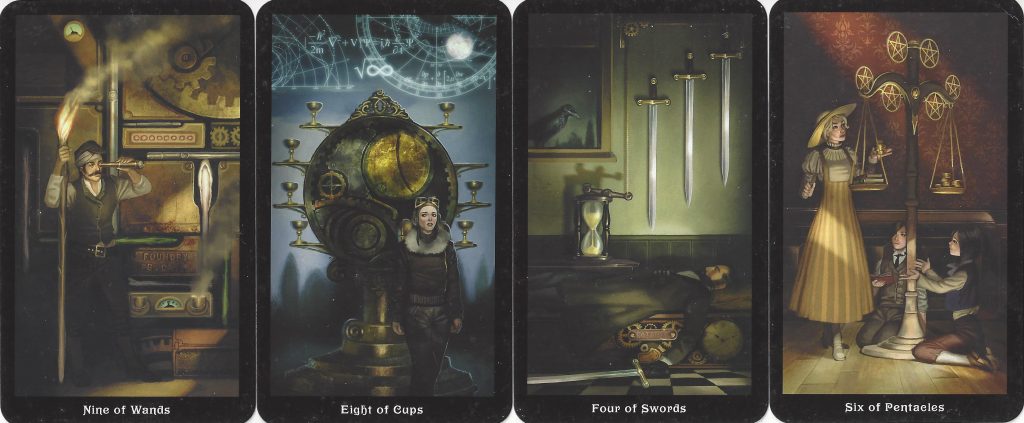

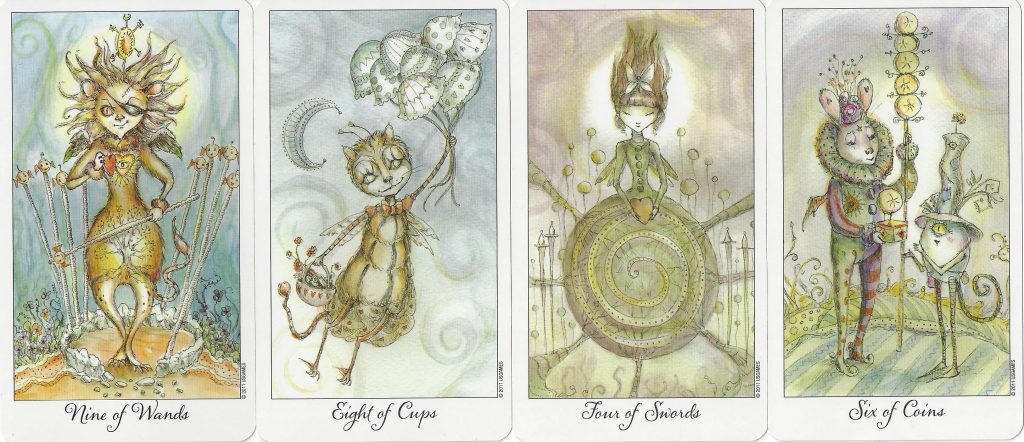
Moody pips have an emotional feel or atmosphere, but don’t show a person (or animal) taking action in the scene.
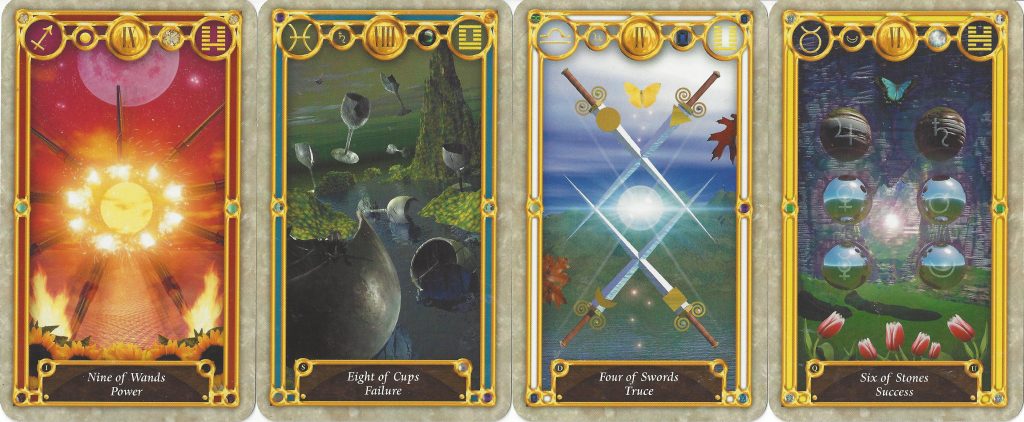
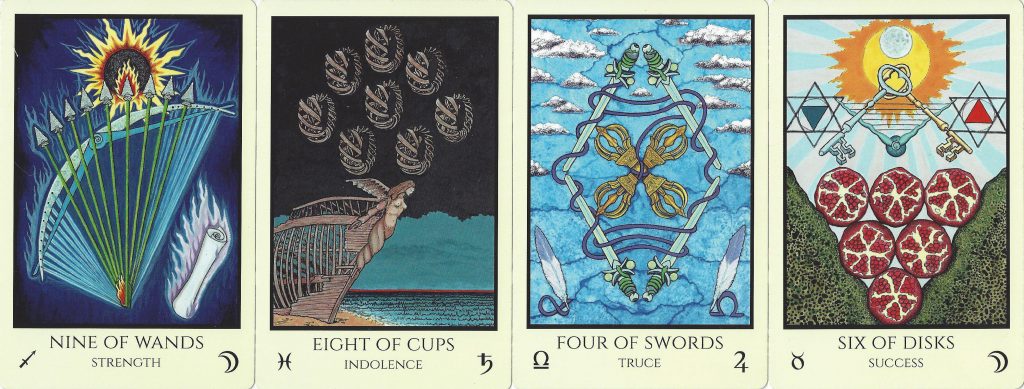
Pip decks have only the suit icons–the wands, cups, swords, or pentacles–and maybe some flowers, vines, or geometric decorations, but nothing else.
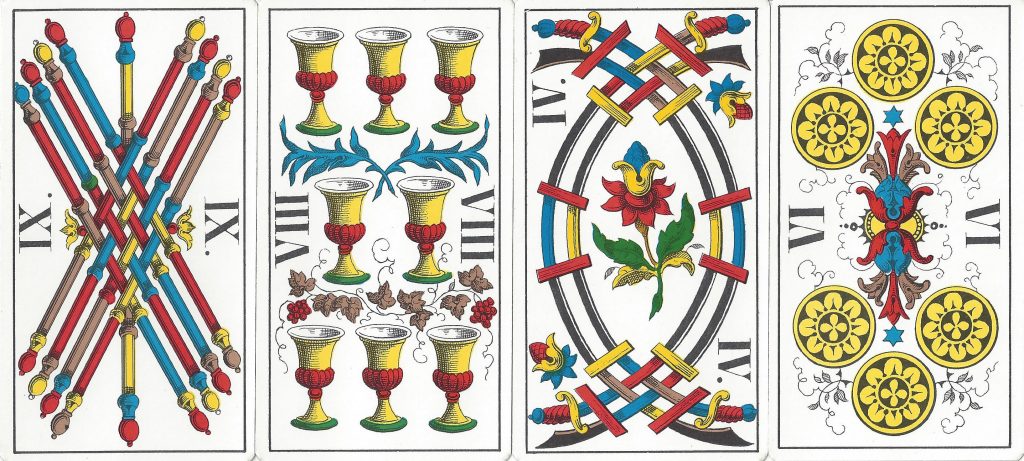

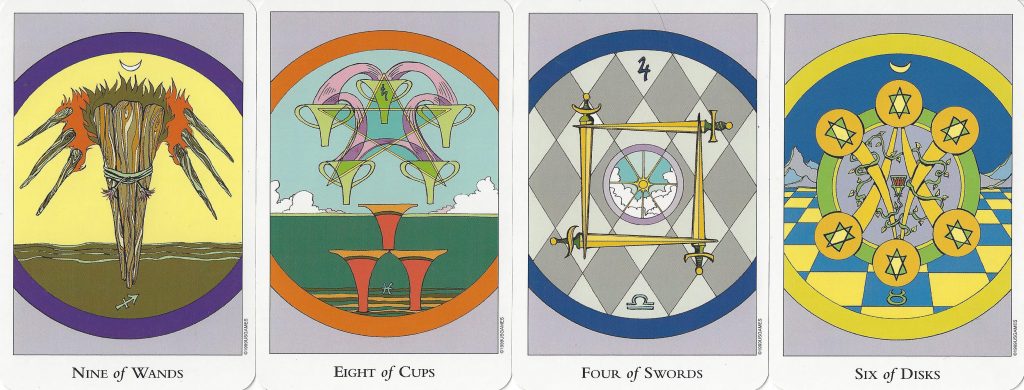
Portrait Cards
In addition to the scenic, moody, or pip designation, there are also portrait cards. In the tarot, the portrait cards are the court cards, which feature an image of a character, often with a look on their face that reveals their emotional state, or an environment that tells something about them. The problem with portrait cards is that they offer character but not action, so although you can tell stories all day about the character, you can’t narrow down the meaning of the card, which is based not on the character, but what choice the character makes. In a tarot reading, the other cards surrounding the court card will display the choices made, exemplified by the actions the character is taking.
However, either tarot or oracle decks can comprise images that are mostly portraits. This is common in oracle decks, and some harder-to-read tarot decks will substitute portrait style artwork for the scenes of the numbered cards. I suggest that you avoid these decks. Portrait cards are challenging to read because your intuitive response will be emotional, such as “This person looks deep in thought” or “This person seems carefree” or “This person looks excited.” Good tarot reading takes us beyond emotions into the specificity of verbs, so that the story progresses.
Why Not Oracle?
Oracle decks are mistakenly considered to be more intuitive. If oracle decks have meanings printed on them and beautiful artwork, wouldn’t that be a better choice? The problem I have observed with students and clients is that if there are words on the cards, people immediately focus on the words, not the artwork. This is why I prefer decks without keywords, and why many tarot readers crop borders and keywords off their decks. Reading words activates a different side of your brain than imagery does, so when you work with oracle cards that have keywords, meanings, or affirmations printed on them, you are actually closing down your intuitive abilities!
Choose Tarot!
There are thousands of tarot decks to choose from, offering a cosmic array of choices in artwork, theme, and symbolism. Don’t limit yourself to a deck marked “beginner” or “easy.” Select a deck with art you love, characters who speak to you, symbolism that piques your curiosity, and scenes that tell you a story. Place three or more cards in a row on a table or counter. Set aside all books and charts of meanings. Disregard any words printed on the card. Allow your intuition to surf on the images, seeking out a path through the scenes, and let the meaning rise up from the depths. Now you’re reading tarot!
Next?
Already have your ideal deck? Check out my post The Best Way to Learn Tarot. If not, then tune in next week and I’ll give you advice on how to select the perfect deck for you from the hundreds you’ll see in the store, or the thousands you’ll find online! When comparing tarot or oracle decks, did you come out on the side of oracle? Please visit my post Tarot vs. Oracles for an exercise to get you started reading oracle cards.
See you next week for the next step of your inTAROTduction!
***
If you’d like to learn to read the tarot with no memorization or books, simply letting the cards speak for themselves, check out my upcoming Magician’s Tools: Beginning Tarot class, Sundays, February 11-March 18, 2018, 2:30-4:30 p.m. at Isis Books and Gifts, 2775 South Broadway, Englewood, CO 80113.
If you’re getting started and want to know the best beginner deck, please take a look at my post on 50 Beginning Tarot Decks.


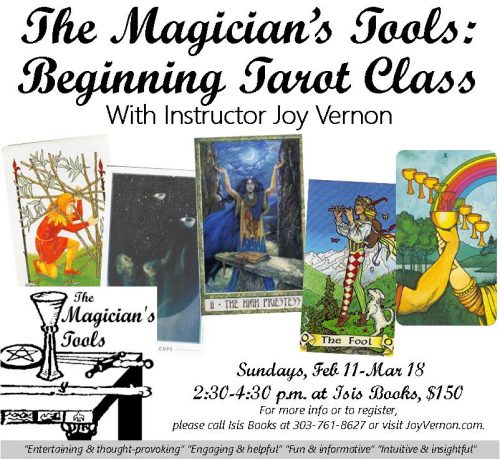




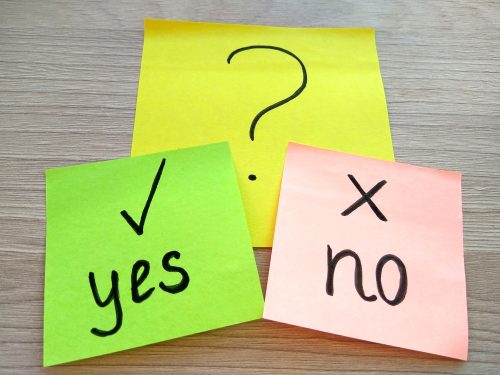

Thank you for addressing this topic so wisely and thoroughly! Love this!
One linguistic comment for you, to make things even more complicated. Technically, the word “oracle” means three things – the person who gives a reading, the tool used for reading, and the message delivered in a reading. So, by definition, tarot decks are also oracle decks. And, you and I are oracles. And, the readings that we give are oracles, too. Fun, right?
I’m a proponent of the term “non-tarot oracle deck” to make this clear, but I bet I will be the only person to every use it.
I also love the term coined by Diane Wilkes, “Taroracle” – this is a tarot deck that strays very far from standard tarot structure so as to venture into the realm of being non-tarot, almost.
Your post is so timely – I see so many assumptions about oracles decks, such as, “oracle decks must always contain angels” and “oracle decks generally have 44 cards”.
I also appreciate the way you made clear the virtues of tarot over oracle decks. For me, both are wonderful, but are certainly not interchangeable in terms of their function. That people misunderstand this irks me. Apparently it irks you too! 🙂
Thank you for shining the light on truth, and being an intelligent advocate for tarot!
Hi Christiana! Thanks so much for the comment!
As to the word “oracle” — I do address that point in my post Tarot vs. Oracles (http://joyvernon.com/Blog/tarot-vs-oracles/). However, I was really trying to write this for someone brand new–the young woman who picked up two decks in the store marked “Oracle decks” and thought they were tarot. So yes, I’m using a very specific, and slightly flawed, but very commonly used connotation, but one that I think most beginners tend to use in this manner. I was trying to keep the post short, hahaha!! For the same reason I didn’t even mention Lenormand.
I like your phrase “non-tarot oracle deck” — I just might join you in using it! For instance, “The Psychic Tarot is a non-tarot oracle deck.” What do you think? 😉
Hmmm. Taroracle. I am pretty willing to accept any deck with a four-suit minor plus a trump suit as a tarot, no matter how far it strays. I’d have to look carefully at some examples in order to be swayed. 🙂 And if it doesn’t have that structure, it’s simply not tarot, or tarot-style oracle. But I think we are starting to see 78-card four-suit plus trumps decks that not only don’t follow any lineage (I’m cool with that) but don’t follow the established scenic/moody/pip style–they only use oracle style portraits instead of tarot style action shots.
That’s why I developed the idea of “Portrait” cards. To find a way to distinguish between common types of tarot decks (scenic, moody, pip) and the more common art style in oracle decks, which tends to be more portraits rather than scenes. I still need to develop this idea so that I can express it better. I first tentatively addressed this in my review of the Art of Love deck (http://joyvernon.com/Blog/love-in-the-cards-4-tarot-decks-for-lovers/). More recently, I was very disappointed with Paulina Cassidy’s SpiritSong Tarot, which is all portraits and no actions. I love the Joie de Vivre, and am still looking forward to her future decks.
I love tarot and am an unflagging advocate for people to see the simplicity of tarot as well as its complexity!
I am so glad to have this time to chat with you! Thank you for the thought-provoking comments, Christiana!
Joy